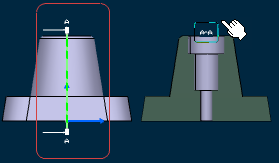Working with Callouts | |||
| |||
Create Callouts in Reference View
You can create callouts for section views, section cuts (including multi-plane section views/cuts) or auxiliary views, in other reference views using the Create Callout in Reference View command. This command is available if at least a single layout view supports callout addition.
![]()
Position Callout Texts Manually
You can position the callout texts freely anywhere using the Position Texts Manually command. This command is available on the contextual menu of callout texts and callout representation.
| Tip: The contextual menu is accessible when the pointer is over callout representation or callout texts. |
![]()
Edit Callouts
You can edit a callout by double-clicking on the callout representation or executing the Definition command from its contextual menu.
Notes:
- You can only edit the projection or section callouts by modifying the location of callout extremities. However, you cannot edit the multi-plane section callouts. Because, such callouts are created from a 2D profile and their extent is explicitly specified through this 2D profile.
- You cannot edit a callout text's string, as its purpose is to reflect the resulting view identifier.




 .
.